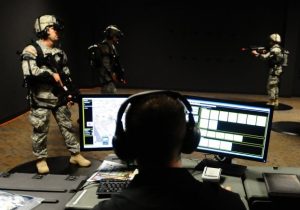> What were the key ideas of the Bauhaus?
After being shunned out of its original home town of Weimar, Germany, the Bauhaus was moved to Dessau, an industrial city fit for this new movement in 1925. Here, the founder Walter Gropius built a strikingly modern piece of architecture to house workshops and theaters through to student accommodation. All designed with art and industry in mind. “Gropius built one of the quintessential expressions of modern architecture, the Bauhaus building of 1925-6.” (Willette, 2011) This description of the architecture and how the building itself was making a statement of Modernism tells us that the future was being designed within.
It was bridging the gap between art and industry which seemed to be the founding message of the school. Allowing art, of futuristic style, to integrate and influence the way art and design moved forward into the future. Gropius was a veteran of WWI and felt grievously affected by war. He saw how industry was a key element to war and wanted to develop change in the way it was used, and so, needed to change social conditions through its culture; art and architecture. ‘We want to create the purely organic building, boldly emanating its inner laws, free of untruths or ornamentation.’ (Groupius, n.d.)
Defining, the modern environment affects the way we live, was also a key task in the lectures and workshops. Observing how the human senses are increasingly more susceptible than original art portrays. Exploring sound and light as part of art as much as architecture. The Bauhaus went out to oppose the currently, known lifestyle. Attempting to make sense of the up and coming, to point out that art should be broadened in the public’s eye.
> Do you feel that the ideas could have an influence on contemporary games design.
Virtual Reality (VR) shouts out modernism. This has a direct link back to the messages of the Bauhaus, considering the future of what could be from what we have now. The ideas I mentioned about; bridging art and industry, changing social conditions for the better and showing how modern environments affect the ways we live, all relate to VR.
The technology is not young, envisioned as far back as the 1930s by science fiction writer Stanley G (TURNER, 2017). In terms of games and games design, VR is the stepping stone into the future. VR is a new platform being used to simulate an environment for people to immerse, play, explore and learn in, changing our social conditions. Flying and roller coaster simulations; Flying Aces VR might be a game for play but within the same genre the military use this technology for training. Not exactly something the Bauhaus principles might have agreed with. Whereas mobile games like VR Roller Coaster are using the technology to push new ways of providing a positive experience for people. (Google Play, 2017)
Looking at the design of war genre games, they have always been limited to people watching a screen at some distance, camera angle controls with the player’s mouse or joystick. With VR, a military game can be designed to provide players that next level of immersion and experience. Placing people as deep into a war like situation without the risk. This is something the ideas of Bauhaus might agree with as it is allowing society a new way of looking at life, from different surroundings.
References
Frag, 2017. VR Roller Coaster. [Online]
Available at: http://frag-mobile.com/app/vr-roller-coaster/
[Accessed 14 10 2017].
Google Play, 2017. VR Roller Coaster. [Online]
Available at: https://play.google.com/store/apps/details?id=com.frag.vrrollercoaster
[Accessed 14 10 2017].
Groupius, W., n.d. Walter Groupius. [Online]
Available at: https://www.bauhaus100.de/en/past/people/directors/walter-gropius/index.html
[Accessed 12 10 2017].
Guenther, S. J., 2012. Virtual reality used to train Soldiers in new training simulator. [Online]
Available at: https://www.army.mil/article/84453/Virtual_reality_used_to_train_Soldiers_in_new_training_simulator/
[Accessed 14 10 2017].
Tate, 1925. Bauhaus. [Online]
Available at: http://www.tate.org.uk/art/art-terms/b/bauhaus
[Accessed 12 10 2017].
TURNER, G., 2017. Soaring through virtual aviation: The role of VR in aerospace manufacturing. [Online]
Available at: http://www.manufacturingglobal.com/technology/soaring-through-virtual-aviation-role-vr-aerospace-manufacturing
[Accessed 06 12 2017].
Warde, B., 1955. The Crystal Goblet, or Printing Should Be Invisible by Beatrice Warde (1900 — 1969). [Online]
Available at: http://gmunch.home.pipeline.com/typo-L/misc/ward.htm
[Accessed 12 10 2017].
Willette, J., 2011. Bauhaus: The End. [Online]
Available at: http://arthistoryunstuffed.com/bauhaus-the-end/
[Accessed 12 10 2017].
Bibliography
http://www.designhistory.org/Bauhaus_pages/BauhausOrigins.html
https://www.theguardian.com/books/2007/nov/17/architecture.art
http://arthistoryunstuffed.com/bauhaus-the-end/
https://www.bauhaus100.de/en/past/people/directors/walter-gropius/index.html
https://www.vrs.org.uk/virtual-reality/history.html
https://www.wearvr.com/apps/flying-aces-vr
https://www.army.mil/article/84453/Virtual_reality_used_to_train_Soldiers_in_new_training_simulator/
https://play.google.com/store/apps/details?id=com.frag.vrrollercoaster
https://www.merriam-webster.com/dictionary/modernism



